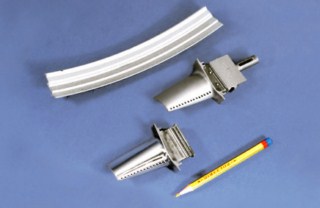The critical components of turbines are rotor blades and nozzle blades whose material and design predetermine the pre-turbine gas temperature limit, hence influencing directly the functional and cost performance of gas turbine engines (GTE). The engineering problems associated with further boosting of the convective cooling of blades, the power-related inadequacy of film curtains and heat exchangers and the current state of the heat resistant alloy metallurgy testify to the fact that improvement of the GTE cycle parameters should intertwine with the development of absolutely new protective systems for gas turbine blades and a transition from heat-resistant composite coatings to thermal-barrier coatings (TBCs).
Some attempts to create thermal protection coatings were undertaken over 60 years ago. However, recently, interest in such coatings has grown up in line with the advent of more advanced GTEs where the active gas temperature approaches to or exceeds the temperature limits applicable to the existing heat-resistant alloys.
The research results demonstrate that application of a 250 µm-thick TBC with the thermal conductivity of 1 W/m2 at two turbine stages allows to attain one of the two possible goals:
- while keeping the operating temperature of the blade material unchanged, it is possible to increase the turbine inlet gas temperature by ca.100°C, thus increasing the turbine efficiency and reducing the fuel consumption by over 13%;
- while keeping the turbine inlet gas temperature unchanged, it is possible to extend the longevity of blades 4 times as a result of the lowered blade operating temperature.
ELTECHMASH applies protective coating on turbine blades by way of electron-beam evaporation of the alloys MeCrAlY (where Me is Ni, Co, Fe), MeCrAIYHfSiZr or Zr02-based ceramics, stabilized by Y203, and subsequent condensation of the vapour phase on the surface of the rotor blades and guide blades of any type of gas turbines.
The coating categories have been developed:
- single-layer metallic coating of the MeCrAlY, MeCrAIYHfSiZr types;
- single-layer composite microlayer type interlacing coatings with interlacing microlayers MeCrAlY (MeCrAIYHfSiZr)-MeCrAIY (MeCrAIYHfSiZr)+MeO (where MeO- Al203 or Zr02+6...8 mass % Y203);
- double-layer coatings consisting of an inner metallic MeCrAlY layer (MeCrAIYHfSiZr) and an outer ceramic layer (Zr02-Y203);
- double-layer coatings consisting of an inner composite MeCrAlY (MeCrAIYHfSiZr)+MeO dispersion-strengthened or microlayered type layer and an outer ceramic layer (Zr02-Y203);
- triple-layer coatings consisting of an inner and intermediate metallic layers based on the alloys MeCrAlY (MeCrAIYHfSiZr) and an outer ceramic layer based on ceramics (Zr02-Y203);
- triple-layer coatings consisting of an inner metallic layer MeCrAlY (MeCrAIYHfSiZr), an intermediate composite MeCrAlY (MeCrAIYHfSiZr)-МеО or dispersion-strengthened or microlayered type layer and an outer ceramic layer (Zr02-Y203).
The ELTECHMASH protective coatings and technologies are protected by Ukrainian Patent No. 42052 dated 15.10.2001.
ELTECHMASH has developed a technique for application of new types of ceramic materials for TBC coatings with enhanced fracture elasticity, which contain the so-called "self-control elements", viz. particles or microlayers able to “cure” any microfissures in ceramic material arising out of the “heating-and-cooling” thermal cycles.
The cost of coating application varies from USD 40 to USD 150 depending on the quantity of blades seated on a mounting fixture and treated simultaneously.
In addition, it is possible to renovate spent (life-expired) blades.
Application of protective coatings allows to:
- increase 2 to 5 times the durability of rotor and guide blades;
- increase the active gas temperature and turbine efficiency.

|

|
|
Gas Turbine Blades: On the left without coating; in the middle with metal coating and on the right with a metal-ceramic double-layer coating |
Samples of gas turbine engine blades and other hot gas path (HGP) components without coating and with protective coating. |
